Rain Attenuation Scaling in South Korea: Experimental Results and Artificial Neural Network
Abstract
:1. Introduction
- In this study, we collected experimentally measured dual-frequency attenuation datasets of terrestrial and slant links with time exceedance percentages of 0.1% and 0.01%, respectively. Subsequently, we applied compatible scaling techniques (frequency and polarization) that fit the collected datasets and examined prediction accuracy with existing scaling techniques.
- We developed an ANN to predict the attenuation for frequency and polarization scaling from the long-term-measured terrestrial and slant links attenuation datasets in South Korea.
2. Rain Attenuation Scaling
2.1. Frequency Scaling
2.2. Polarization Scaling
2.3. Discussion on ITU-R Model: South Korea Perspective
- In Table 1, some dual frequency-based experimental measured datasets are presented and the performance of frequency scaling of ITU-R P.530-17 is evaluated. The table shows the prediction error using the ITU-R [36] of terrestrial links with rain exceedance percentages of 0.1% and 0.01%. It is worth mentioning that, in radio network planning, the percentage of time exceedance helps determine link budget availability in horizontal and slant link designs. The availability indices used in link budget planning are typically 0.01 percent of the time exceedance used as link budget fade threshold. Above 0.01% of the time exceedance, the attenuation may lead to network outage. According to Table 1, the measured dataset in Italy showed comparatively good performance to predict attenuation at 83 GHz from the 73 GHz measured dataset. While the dataset in Korea from separate two experimental results ([42] and measured data by the National Radio Research Agency (RRA) [43] station—reported in Section 3) does not fit well by the ITU-R P.530-17 model, with showing errors 63% (at 83 GHz) [42], and 63% (at 38 GHz) for measured data by RRA [43].
| (a) | (b) | ||||||
|---|---|---|---|---|---|---|---|
| Ref. | F1 (GHz) | F2 (GHz) | A1 (dB) | A2 (dB) | ITU-R [37] | Error% [37] | |
| 0.1% | Japan [35] | 12.65 | 18.9 | 10 | 20 | 21 | −5 |
| Darmstadt [13] | 12.5 | 20 | 6 | 12 | 14 | 17 | |
| Darmstadt [13] | 20 | 30 | 12 | 24 | 23 | −4 | |
| Virginia Tech [44] | 12 | 20 | 5 | 15 | 13 | −13 | |
| Virginia Tech [44] | 20 | 30 | 12 | 25 | 23 | −8 | |
| Measured | 19.8 | 20.73 | 13 | 12 | 14 | 17 | |
| 0.01% | Japan [35] | 12.65 | 18.9 | 14 | 24 | 28 | 17 |
| Darmstadt [13] | 12.5 | 20 | 11 | 27 | 25 | −7 | |
| Darmstadt [13] | 20 | 30 | 27 | 51 | 47 | −8 | |
| Virginia Tech [44] | 12 | 20 | 12 | 29 | 29 | 0 | |
| Virginia Tech [44] | 20 | 30 | 29 | 44 | 50 | 14 | |
| Measured | 19.8 | 20.73 | 25 | 18 | 27 | 50 | |
- The relative errors due to frequency scaling of ITU-R P.618-13 model of slant links with rain times exceeding 0.1% and 0.01% are shown in Table 2. As we can see, the predicted error performance of the ITU-R model [37] shows good prediction ability for the data measured at Darmstadt [13] and data measured by Virginia Tech [44] at 20 GHz. On the other hand, the measured results in Korea showed a comparatively higher error generated by the ITU-R P.618-13 model.
3. Experimental Setup
3.1. Terrestrial Links
- 38 GHz vertical polarization
- 18 GHz horizontal polarization
- 18 GHz vertical polarization
3.2. Slant Links
4. Proposed Model
5. Results and Discussion
- We applied the proposed ANN model to find frequency-scaled attenuation for the terrestrial link (see Figure 5);
- We applied the proposed ANN model to find frequency-scaled attenuation for slant links (see Figure 6);
- We applied the proposed ANN model to find the scaled attenuation for terrestrial link polarization scaling (see Figure 7);
- We applied the proposed ANN model to find the scaled attenuation for polarization scaling (see Figure 8).
- Figure 5 shows the measured attenuation versus the time exceedance percentage of the experimental terrestrial link using frequency scaling. Here, the measured attenuation means the attenuation obtained from the recorded RSL for the 38 GHz radio link. The red line marked by the small circle represents the predicted attenuation generated through the ANN network taking attenuation at 18 GHz as input and attenuation at 38 GHz as a target. In the same figure, the black line represents the attenuation obtained by scaling from 18 GHz to 38 GHz using the existing ITU-R P.530-17 formula. As shown in the figure, the overall attenuation predicted by the ANN model is well-matched to the measurement compared to the value predicted by the ITU-R P.530-17 scaled formula.
- Figure 6 shows the frequency scaling plot from 12 GHz to 20 GHz frequency for satellite links, and the description of this figure is almost the same as that in Figure 5, except for the slant link case application. The figure shows that the predicted attenuation through the ANN is closer to the measured result compared to the ITU-R scaled attenuation. Overall, the ANN model also showed good performance in predicting the attenuation of the slant link.
- Figure 7 depicts the performance of polarization scaling of rain attenuation comparison among measured, scaled through the ANN model, and scaled using the ITU-R model [36] at 18 GHz over the terrestrial link. The scaling was undertaken from the 18 GHz horizontal to the 18 GHz vertical polarization. Here, the ITU-R-generated attenuation was less compared to the measured attenuation. Considering the four points, at two points the proposed ANN model showed better performance than the ITU-R model, while for one point ANN and ITU-R are the same, and for one point, ANN did not show better performance than the ITU-R model. Therefore, the overall performance is satisfactory compared to the ITU-R P.530-17 scaled model.
- Figure 8 shows the reverse prediction technique compared to Figure 7, where the predicted attenuation is plotted for an 18 GHz horizontal link from the 18 GHz vertically polarized measured rain attenuation datasets. Here, the performance of the proposed ANN model is not satisfactory. On the other hand, the ITU-R model comparatively shows better prediction capability as the predicted attenuation matches the measured attenuation for most of the rain attenuation time exceedance.
6. Conclusions
Author Contributions
Funding
Data Availability Statement
Acknowledgments
Conflicts of Interest
References
- Samad, M.A.; Diba, F.D.; Choi, D.Y. A Survey of Rain Attenuation Prediction Models for Terrestrial Links—Current Research Challenges and State-of-the-Art. Sensors 2021, 21, 1207. [Google Scholar] [CrossRef] [PubMed]
- Diba, F.D.; Afullo, T.J.; Alonge, A.A. Rainfall Rate and Attenuation Performance Analysis at Microwave and Millimeter Bands for the Design of Terrestrial Line-of-Sight Radio Links in Ethiopia. SAIEE Afr. Res. J. 2016, 107, 177–186. [Google Scholar] [CrossRef]
- Samad, M.A.; Diba, F.D.; Choi, D.Y. A Survey of Rain Fade Models for Earth–Space Telecommunication Links—Taxonomy, Methods, and Comparative Study. Remote Sens. 2021, 13, 1965. [Google Scholar] [CrossRef]
- Arapoglou, P.D.M.; Panagopoulos, A.D.; Cottis, P.G. An Analytical Prediction Model of Time Diversity Performance for Earth-Space Fade Mitigation. Int. J. Antennas Propag. 2008, 2008, 1–5. [Google Scholar] [CrossRef]
- Abdulrahman, A.Y.; Bin Abd Rahman, T.; Rahim, S.K.B.A.; Islam, M.R.U. A New Rain Attenuation Conversion Technique for Tropical Regions. Prog. Electromagn. Res. B 2010, 26, 53–67. [Google Scholar] [CrossRef] [Green Version]
- Laster, J.D.; Stutzman, W.L. Frequency scaling of rain attenuation for satellite communication links. IEEE Trans. Antennas Propag. 1995, 43, 1207–1216. [Google Scholar] [CrossRef]
- Tomaz, L.M.; Capsoni, C.; Luini, L. Scaling Rain Attenuation as a Function of the Link Elevation. In Proceedings of the 2018 2nd URSI Atlantic Radio Science Meeting (AT-RASC), Gran Canaria, Spain, 28 May–1 June 2018; IEEE: Piscataway, NJ, USA, 2018. [Google Scholar] [CrossRef]
- Zemba, M.; Nessel, J.; Houts, J.; Luini, L.; Riva, C. Statistical analysis of instantaneous frequency scaling factor as derived from optical disdrometer measurements at K/Q bands. In Proceedings of the 2016 10th European Conference on Antennas and Propagation (EuCAP), Davos, Switzerland, 10–15 April 2016; IEEE: Piscataway, NJ, USA, 2016. [Google Scholar] [CrossRef] [Green Version]
- Cuervo, F.; Plimon, K.; Schonhuber, M.; Martellucci, A.; Castro, J.R. Alphasat Aldo Paraboni propagation experiment in Graz—Frequency scaling analysis. In Proceedings of the 2016 10th European Conference on Antennas and Propagation (EuCAP), Davos, Switzerland, 10–15 April 2016; IEEE: Piscataway, NJ, USA, 2016. [Google Scholar] [CrossRef]
- Acharya, R. A simple real-time frequency scaling technique for rain attenuation and its performance. Int. J. Satell. Commun. Netw. 2020, 38, 329–340. [Google Scholar] [CrossRef]
- Ulaganathen, K.; Rahman, T.A.; Rahim, S.K.A.; Islam, R.M. Review of Rain Attenuation Studies in Tropical and Equatorial Regions in Malaysia: An Overview. IEEE Antennas Propag. Mag. 2013, 55, 103–113. [Google Scholar] [CrossRef]
- Bertorelli, S.; Paraboni, A. Modelling of short-term frequency scaling for rain attenuation using ITALSAT data. Int. J. Satell. Commun. Netw. 2007, 25, 251–262. [Google Scholar] [CrossRef]
- Dintelmann, F.; Ortgies, G.; Ruecker, F.; Jakoby, R. Results from 12-to 30-GHz German propagation experiments carried out with radiometers and the Olympus satellite. Proc. IEEE 1993, 81, 876–884. [Google Scholar] [CrossRef]
- Karagiannis, G.A.; Panagopoulos, A.D.; Kanellopoulos, J.D. Short-Term Rain Attenuation Frequency Scaling for Satellite Up-Link Power Control Applications. IEEE Trans. Antennas Propag. 2013, 61, 2829–2837. [Google Scholar] [CrossRef]
- Kvicera, V.; Grabner, M.; Fiser, O. Frequency scaling of rain attenuation based on 4-year statistics obtained on two parallel terrestrial paths at 58 GHz and 93 GHz. In Proceedings of the 2012 42nd European Microwave Conference, Amsterdam, The Netherlands, 29 October–1 November 2012; IEEE: Piscataway, NJ, USA, 2012. [Google Scholar] [CrossRef]
- Kheirallah, H.; Olsen, R. Comparison of a one- and a two-frequency technique for frequency scaling of rain attenuation statistics. Electron. Lett. 1982, 18, 51. [Google Scholar] [CrossRef]
- Brisseau, O.; Mallet, C.; Barthes, L.; Marsault, T. Frequency scaling of rain attenuation based on microphysical characteristics for SatCom links. IEEE Proc. Microwaves Antennas Propag. 2006, 153, 523. [Google Scholar] [CrossRef]
- Kvicera, V.; Grabner, M.; Fiser, O. Frequency and polarization scaling of rain attenuation on 58 and 93 GHz terrestrial links. In Proceedings of the 2007 European Microwave Conference, Munich, Germany, 9–12 October 2007; IEEE: Piscataway, NJ, USA, 2007. [Google Scholar] [CrossRef]
- Usha, A.; Karunakar, G. Preliminary analysis of rain attenuation and frequency scaling method for satellite communication. Indian J. Phys. 2020, 95, 1033–1040. [Google Scholar] [CrossRef]
- Luini, L.; Panzeri, A.; Riva, C.G. Enhancement of the Synthetic Storm Technique for the Prediction of Rain Attenuation Time Series at EHF. IEEE Trans. Antennas Propag. 2020, 68, 5592–5601. [Google Scholar] [CrossRef]
- Laster, J.D. Frequency Scaling of Rain Attenuation on Satellite Links in the Ku/Ka-Bands Using OLYMPUS Satellite Data. Ph.D. Thesis, Virginia Tech, Blacksburg, VA, USA, 1993. [Google Scholar]
- Ihara, T.; Furuhama, Y. Frequency scaling of rain attenuation at centimeter and millimeter waves using a path-averaged drop size distribution. Radio Sci. 1981, 16, 1365–1372. [Google Scholar] [CrossRef]
- Islam, M.; Chebil, J.; Tharek, A. Frequency scaling of rain attenuation from 23- to 38-GHz microwave signals measured in Malaysia. In Proceedings of the 1999 Asia Pacific Microwave Conference. APMC’99. Microwaves Enter the 21st Century. Conference Proceedings (Cat. No.99TH8473), Singapore, 30 November–3 December 1999; IEEE: Piscataway, NJ, USA, 1999. [Google Scholar] [CrossRef]
- Diba, F.D.; Samad, M.A.; Ghimire, J.; Choi, D.Y. Wireless Telecommunication Links for Rainfall Monitoring: Deep Learning Approach and Experimental Results. IEEE Access 2021, 9, 66769–66780. [Google Scholar] [CrossRef]
- Mandeep, J.; Hassan, S.; Tanaka, K. Rainfall measurements at Ku-band satellite link in Penang, Malaysia. IET Microwaves Antennas Propag. 2008, 2, 147–151. [Google Scholar] [CrossRef]
- Yussuff, A.I.; Khamis, N.H. Rain Attenuation Modelling and Mitigation in The Tropics: Brief Review. Int. J. Electr. Comput. Eng. IJECE 2012, 2, 748–757. [Google Scholar] [CrossRef]
- Mandeep, J. Analysis of rain attenuation prediction models at Ku-band in Thailand. Adv. Space Res. 2012, 49, 566–571. [Google Scholar] [CrossRef]
- Allnutt, J. Evolutionary architectures for future multimedia services. In Proceedings of the IEE Colloquium: ‘What’s New in Satellite Communications?’, London, UK, 17 April 1996; IET: Stevenage, UK, 1996. [Google Scholar] [CrossRef]
- Shrestha, S.; Choi, D.Y. Characterization of Rain Specific Attenuation and Frequency Scaling Method for Satellite Communication in South Korea. Int. J. Antennas Propag. 2017, 2017, 1–16. [Google Scholar] [CrossRef]
- Theodoridis, S. Machine Learning: A Bayesian and Optimization Perspective; Academic Press: Cambridge, MA, USA, 2015. [Google Scholar]
- Thiennviboon, P.; Wisutimateekorn, S. Rain Attenuation Prediction Modeling for Earth-Space Links using Artificial Neural Networks. In Proceedings of the 2019 16th International Conference on Electrical Engineering/Electronics, Computer, Telecommunications and Information Technology (ECTI-CON), Pattaya, Thailand, 10–13 July 2019; IEEE: Piscataway, NJ, USA, 2019. [Google Scholar] [CrossRef]
- Shayea, I.; Rahman, T.A.; Azmi, M.H.; Islam, M.R. Real Measurement Study for Rain Rate and Rain Attenuation Conducted Over 26 GHz Microwave 5G Link System in Malaysia. IEEE Access 2018, 6, 19044–19064. [Google Scholar] [CrossRef]
- Samad, M.A.; Choi, D.Y. Learning-Assisted Rain Attenuation Prediction Models. Appl. Sci. 2020, 10, 6017. [Google Scholar] [CrossRef]
- Kvicera, V.; Grabner, M.; Fiser, O. Frequency and path length scaling based on long-term statistics of rain attenuation on terrestrial paths at 38 GHz and 58 GHz. In Proceedings of the 2012 6th European Conference on Antennas and Propagation (EUCAP), Prague, Czech Republic, 26–30 March 2012; IEEE: Piscataway, NJ, USA, 2012. [Google Scholar] [CrossRef]
- Chujo, W.; Manabe, T.; Yamamoto, S.i.; Suzuki, K. Dual frequency use technique for 40-GHz satellite communication during rainfall attenuation. In Proceedings of the 2015 International Symposium on Antennas and Propagation (ISAP), Hobart, Australia, 9–12 November 2015; IEEE: Piscataway, NJ, USA, 2015; pp. 1–3. [Google Scholar]
- ITU Radio Propagation Series. ITU-R P.530-17: Propagation Data and Prediction Methods Required for the Design of Terrestrial Line-of-Sight Systems; Report; ITU-R: Geneve, Switzerland, 2017. [Google Scholar]
- ITU-R Recommendations. P.618-13: Propagation Data and Prediction Methods Required for the Design of Earth-Space Telecommunication Systems; Report; ITU-R Recommendations: Geneve, Switzerland, 2017. [Google Scholar]
- Hodge, D. Frequency scaling of rain attenuation. IEEE Trans. Antennas Propag. 1977, 25, 446–447. [Google Scholar] [CrossRef]
- Filho, F.M.; Cole, R.; Sarma, A. Millimetre-wave rain induced attenuation: Theory and experiment. IEEE Proc. H-Microwaves Antennas Propag. 1986, 133, 308. [Google Scholar] [CrossRef]
- Budalal, A.A.H.; Islam, M.R.; Abdullah, K.; Rahman, T.A. Modification of Distance Factor in Rain Attenuation Prediction for Short-Range Millimeter-Wave Links. IEEE Antennas Wirel. Propag. Lett. 2020, 19, 1027–1031. [Google Scholar] [CrossRef]
- Luini, L.; Roveda, G.; Zaffaroni, M.; Costa, M.; Riva, C.G. The Impact of Rain on Short E -Band Radio Links for 5G Mobile Systems: Experimental Results and Prediction Models. IEEE Trans. Antennas Propag. 2020, 68, 3124–3134. [Google Scholar] [CrossRef]
- Kim, J.H.; Jung, M.W.; Yoon, Y.K.; Chong, Y.J. The measurements of rain attenuation for terrestrial link at millimeter wave. In Proceedings of the 2013 International Conference on ICT Convergence (ICTC), Jeju Island, Korea, 14–16 October 2013; IEEE: Piscataway, NJ, USA, 2013; pp. 848–849. [Google Scholar] [CrossRef]
- National Radio Research Agency (RRA). 767, Bitgaram-ro, Najusi, Jeollanam-do 58217, Korea. Available online: http://rra.go.kr/en/index.do (accessed on 19 August 2021).
- Stutzman, W.L.; Pratt, T.; Safaai-Jazi, A.; Remaklus, P.W.; Laster, J.; Nelson, B.; Ajaz, H. Results from the Virginia Tech propagation experiment using the Olympus satellite 12, 20 and 30 GHz beacons. IEEE Trans. Antennas Propag. 1995, 43, 54–62. [Google Scholar] [CrossRef]
- Diba, F.D.; Samad, M.A.; Choi, D.Y. The Effects of Rain on Terrestrial Links at K, Ka and E-Bands in South Korea: Based on Supervised Learning. IEEE Access 2021, 9, 9345–9355. [Google Scholar] [CrossRef]
- Shrestha, S.; Choi, D.Y. Rain Attenuation Study over an 18GHz Terrestrial Microwave Link in South Korea. Int. J. Antennas Propag. 2019, 2019, 1–16. [Google Scholar] [CrossRef] [Green Version]
- Musafer, H.; Abuzneid, A.; Faezipour, M.; Mahmood, A. An Enhanced Design of Sparse Autoencoder for Latent Features Extraction Based on Trigonometric Simplexes for Network Intrusion Detection Systems. Electronics 2020, 9, 259. [Google Scholar] [CrossRef] [Green Version]
- Abhishek, K.; Kumar, A.; Ranjan, R.; Kumar, S. A rainfall prediction model using artificial neural network. In Proceedings of the 2012 IEEE Control and System Graduate Research Colloquium, Shah Alam, Malaysia, 16–17 July 2012; IEEE: Piscataway, NJ, USA, 2012. [Google Scholar] [CrossRef]


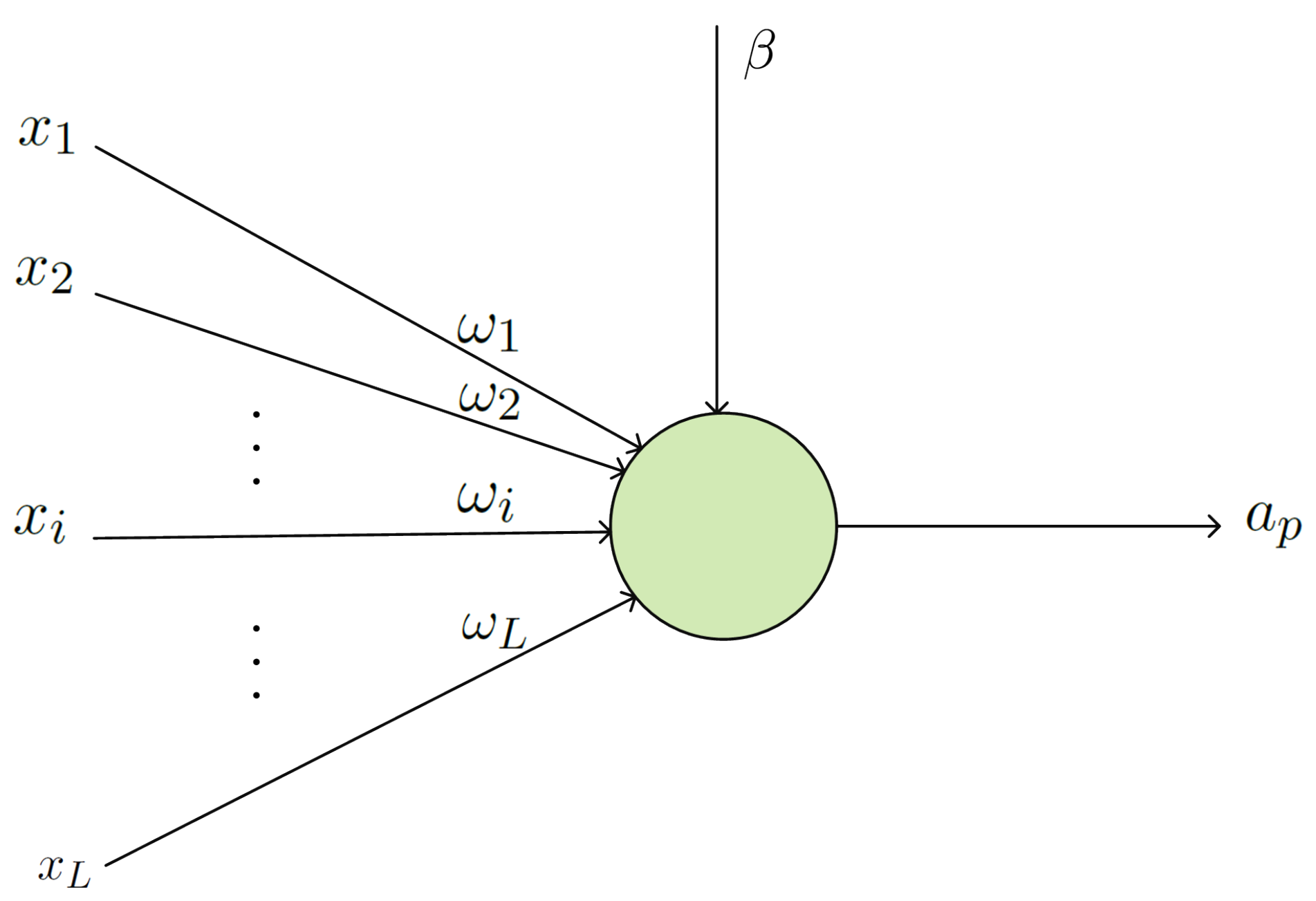
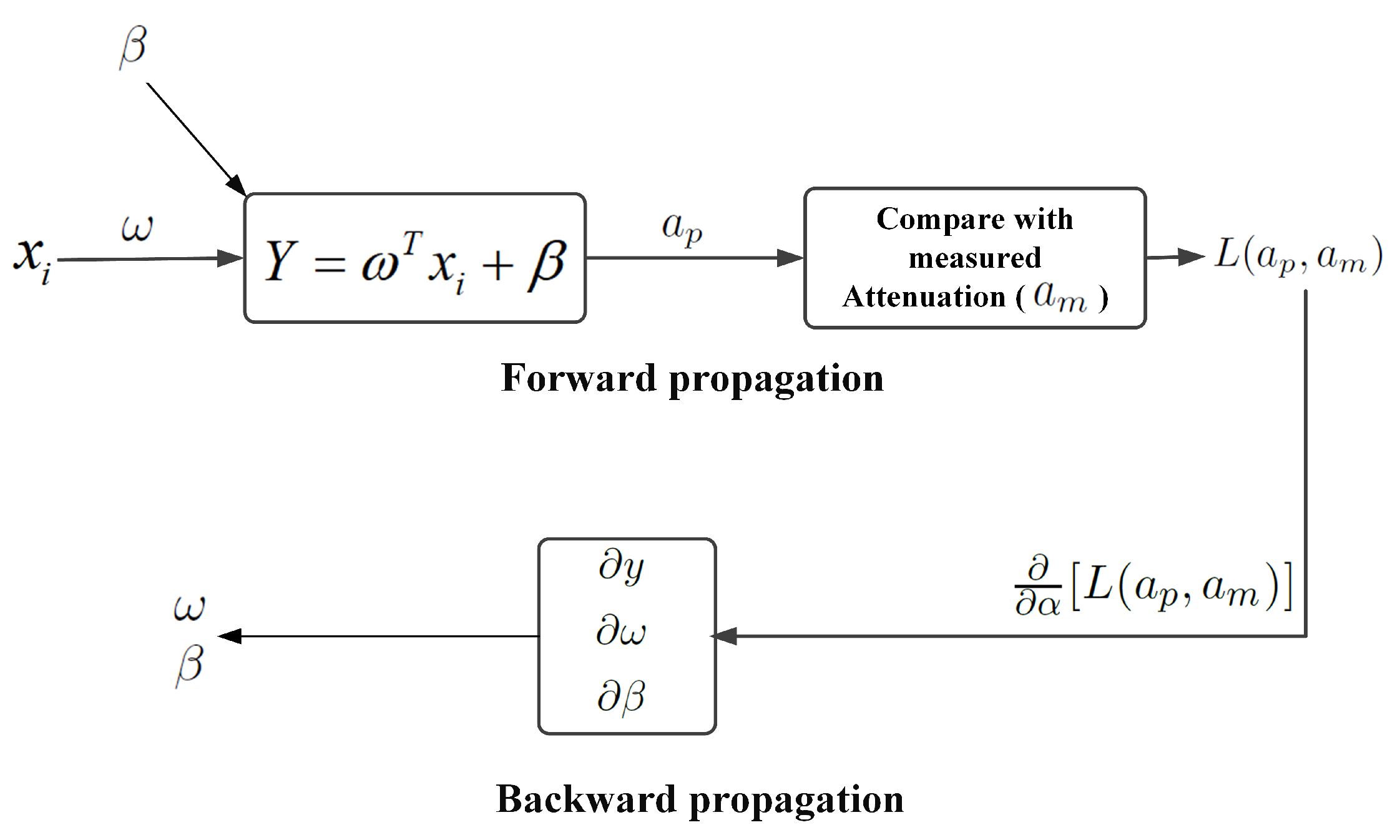
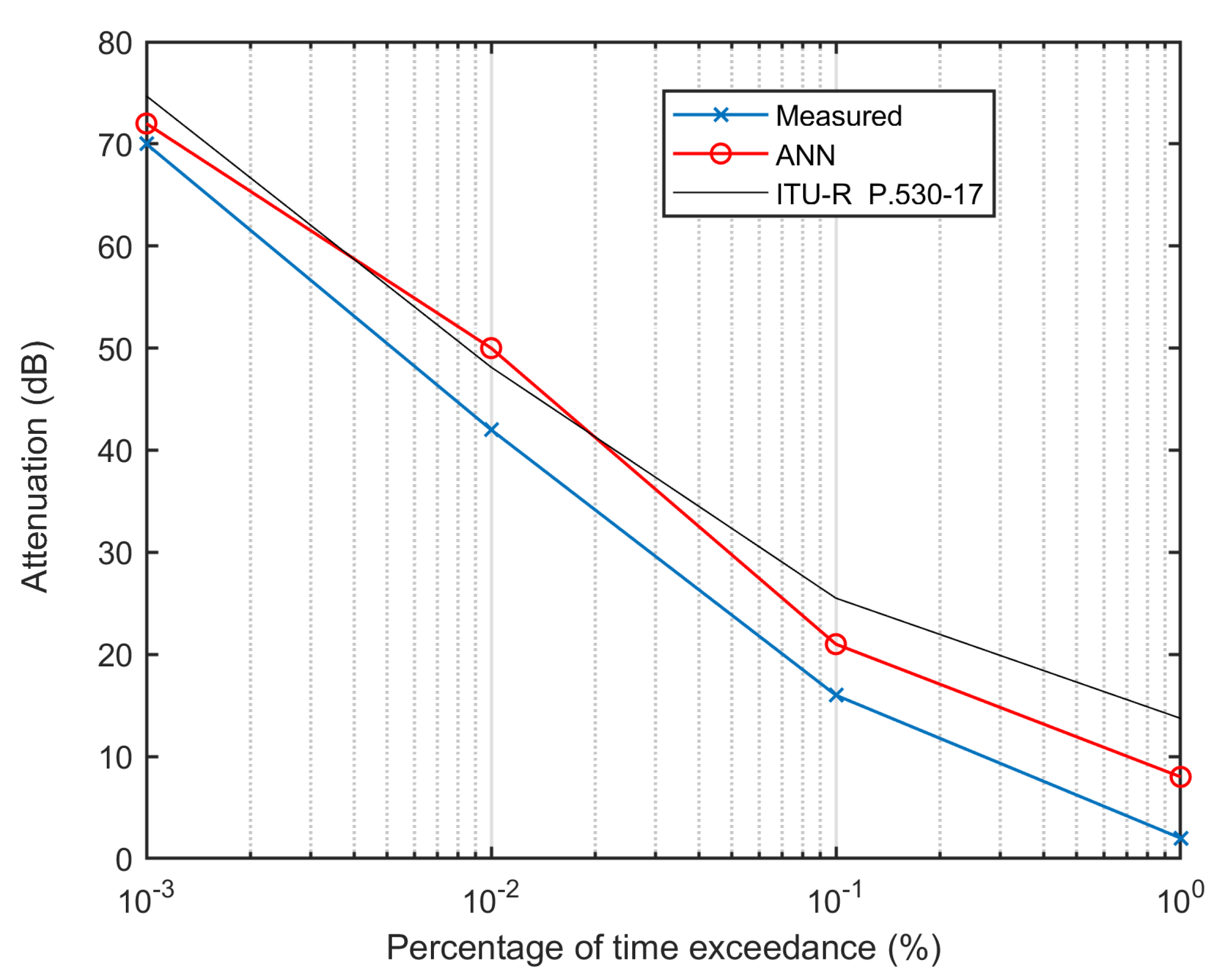
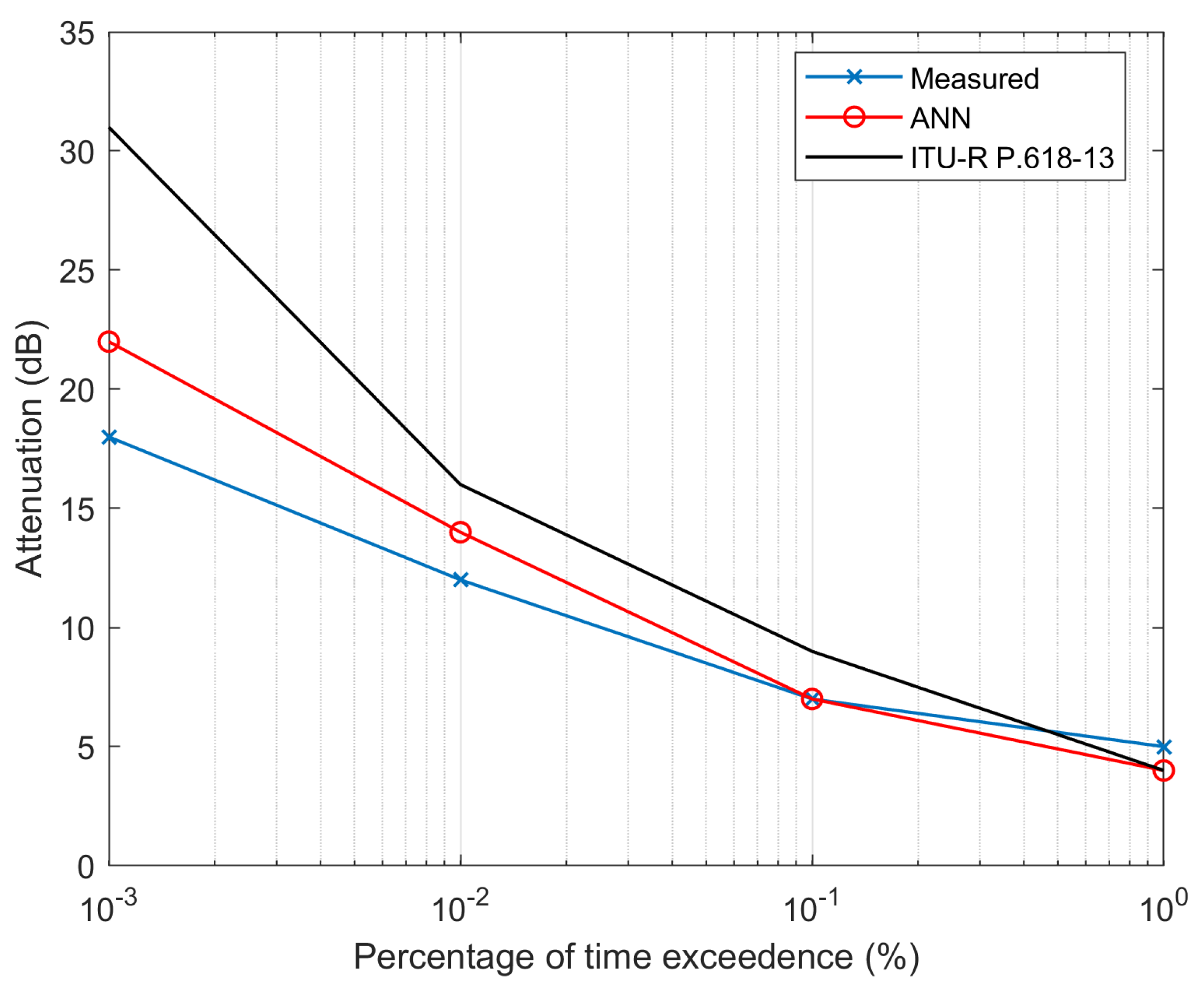
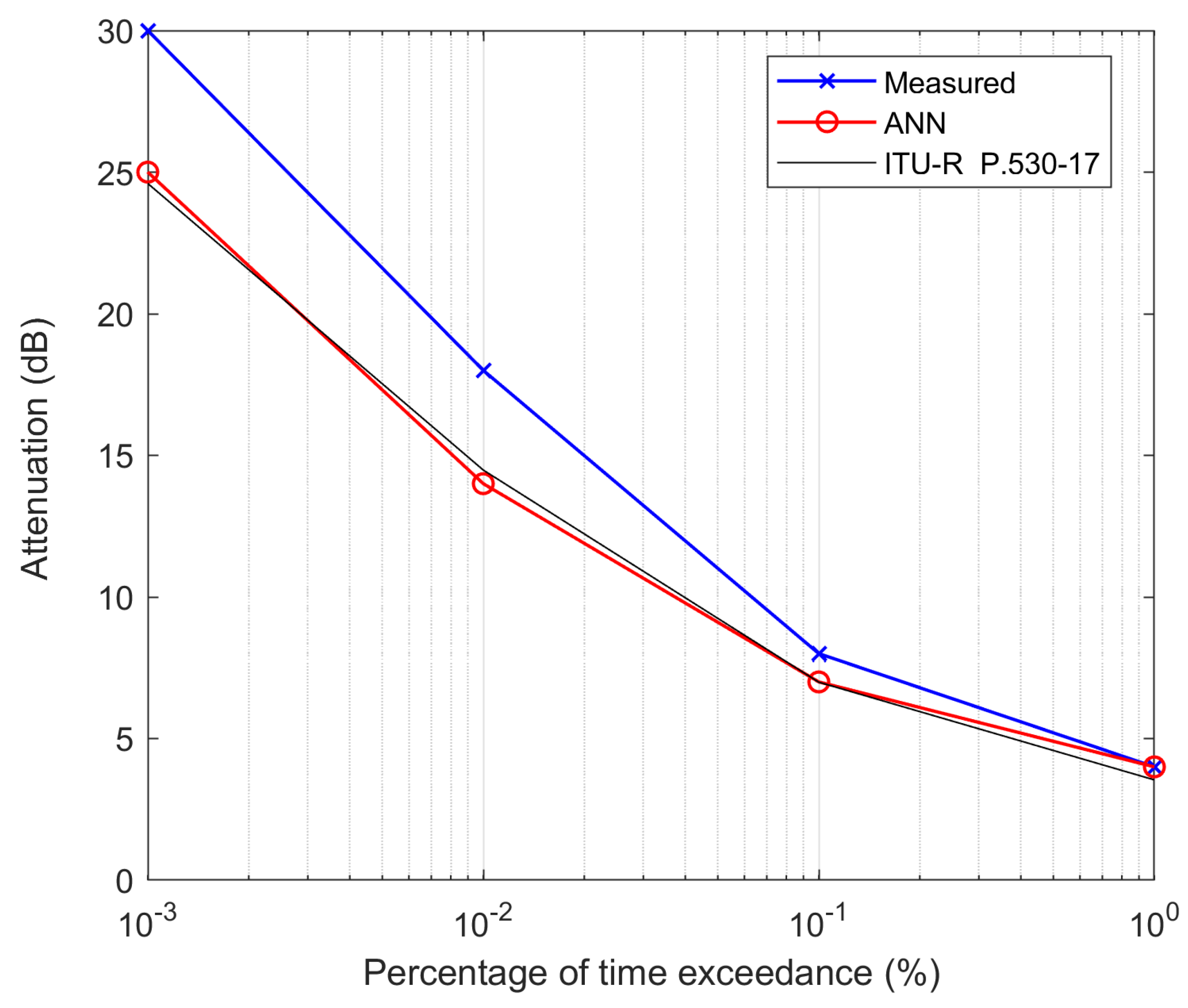
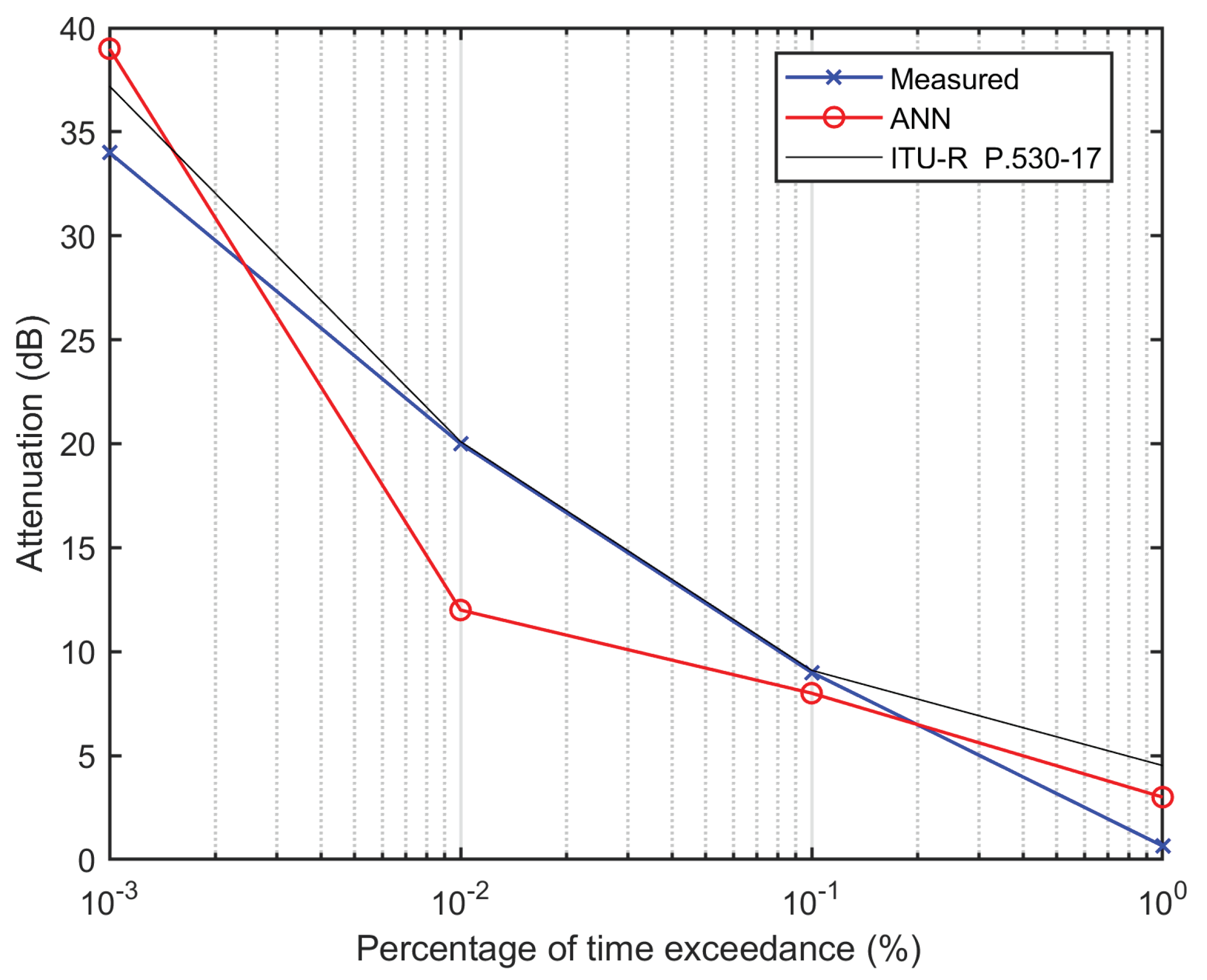
| (a) | (b) | ||||||
|---|---|---|---|---|---|---|---|
| Ref. | F1 (GHz) | F2 (GHz) | A1 (dB) | A2 (dB) | ITU-R [36] | Error% [36] | |
| UK [39] | 36 | 55 | 8 | 12 | 14 | 17 | |
| Malaysia [40] | 26 | 38 | 4.8 | 5.5 | 9 | 64 | |
| 0.1% | Italy [41] | 73 | 83 | 1.66 | 2 | 2 | 0 |
| Korea [42] | 73 | 83 | 12 | 8 | 13 | 63 | |
| Measured | 18 | 38 | 8 | 16 | 26 | 63 | |
| UK [39] | 36 | 55 | 18 | 22 | 28 | 27 | |
| Malaysia [40] | 26 | 38 | 11 | 15 | 19 | 27 | |
| 0.01% | Italy [41] | 73 | 83 | 24 | 24 | 26 | 8 |
| Korea [42] | 73 | 83 | 4 | 4.2 | 4.5 | 7 | |
| Measured | 18 | 38 | 17 | 41 | 48 | 17 | |
| Description | 18 GHz (V) | 18 GHz (H) | 38 GHz |
|---|---|---|---|
| Antenna type | Front-fed parabolic | Front-fed parabolic | Front-fed parabolic |
| Antenna height (TX) | 30 m | 30 m | 30 m |
| Antenna height (RX) | 30 m | 30 m | 30 m |
| Path length | 3.2 km | 3.2 km | 3.2 km |
| Frequency band | 17.7–18.2 | 17.7–18.2 | 38.3–38.9 |
| Polarization | vertical | horizontal | vertical |
| Maximum transmit power | 22 dBm | 22 dBm | 18 dBm |
| Modulation type | QPSK | QPSK | QPSK |
| Spectral efficiency | 8 bit/Hz | 8 bit/Hz | 8 bit/Hz |
| BER received threshold (dBm) | −32.8 | −52.34 | −29.88 |
| Half power beam width | 1.9 | 1.9 | 0.9 |
| Antennas size (m) | 0.6 | 0.6 | 0.6 |
| Gain (dBi) | 38.8 | 38.8 | 45.1 |
| Parameters | Quantity |
|---|---|
| Elevation angle | 45 |
| Azimuth angle | 197.5 |
| Sea level (km) | 0.055 |
| Antenna type | Offset parabolic |
| Frequency band (GHz) | 10.95–31 |
| Beacon signal level for clear sky at 12.25 GHz | −80.5 dBm |
| Beacon signal level for clear sky at 20.73 GHz | −38.7 dBm |
| Polarization | Circular |
| Gain | 55 dB ± 2 dB |
| Type | OTT Parsivel |
| Measuring area | 54 cm2 |
| Scaling | Description of Training Data |
|---|---|
| 18 GHz to 38 GHz (frequency scaling) | Input data: attenuation at 18 GHz Target data: attenuation at 38 GHz |
| 12 GHz to 20 GHz (frequency scaling) | Input data: attenuation at 12 GHz Target data: attenuation at 20 GHz |
| 18 GHz (H) to 18 GHz (V) (Polarization scaling) | Input data: attenuation at 18 GHz (H) Target data: attenuation at 18 GHz (V) |
| 18 GHz (V) to 18 GHz (H) (Polarization scaling) | Input data: attenuation at 18 GHz (V) Target data: attenuation at 18 GHz (H) |
Publisher’s Note: MDPI stays neutral with regard to jurisdictional claims in published maps and institutional affiliations. |
© 2021 by the authors. Licensee MDPI, Basel, Switzerland. This article is an open access article distributed under the terms and conditions of the Creative Commons Attribution (CC BY) license (https://creativecommons.org/licenses/by/4.0/).
Share and Cite
Samad, M.A.; Diba, F.D.; Choi, D.-Y. Rain Attenuation Scaling in South Korea: Experimental Results and Artificial Neural Network. Electronics 2021, 10, 2030. https://doi.org/10.3390/electronics10162030
Samad MA, Diba FD, Choi D-Y. Rain Attenuation Scaling in South Korea: Experimental Results and Artificial Neural Network. Electronics. 2021; 10(16):2030. https://doi.org/10.3390/electronics10162030
Chicago/Turabian StyleSamad, Md Abdus, Feyisa Debo Diba, and Dong-You Choi. 2021. "Rain Attenuation Scaling in South Korea: Experimental Results and Artificial Neural Network" Electronics 10, no. 16: 2030. https://doi.org/10.3390/electronics10162030
APA StyleSamad, M. A., Diba, F. D., & Choi, D.-Y. (2021). Rain Attenuation Scaling in South Korea: Experimental Results and Artificial Neural Network. Electronics, 10(16), 2030. https://doi.org/10.3390/electronics10162030






